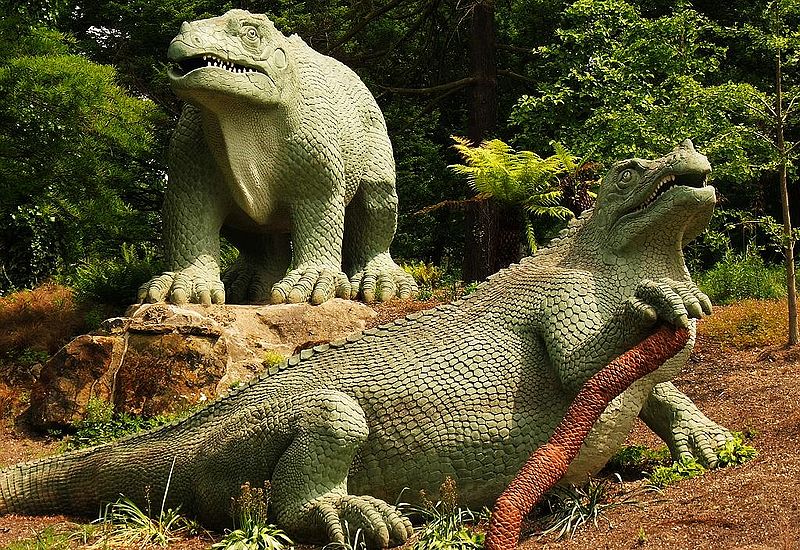Why the MoMA Should Have Dinosaurs
/https://tf-cmsv2-smithsonianmag-media.s3.amazonaws.com/filer/20110520083319moma-complaint.jpg)
The Museum of Modern Art needs dinosaurs. That was the conclusion of one young visitor named Annabelle after she failed to find any dinosaurs at the MoMA. "ou call your self a museum!" she chided on a comment cards, and her brief critique has been popping up all over the web this week.
Not everyone has been very sympathetic to Annabelle's disappointment. At The Hairpin, Edith Zimmerman shot back the snarky reply: "Why don't you figure out what museum you're at." Jezebel's Margaret Hartmann wondered if Annabelle had been "confused about the field trip's destination." Hartmann might be right—I know I'd feel let down if I was expecting to visit the AMNH and wound up at the MoMA—but I think Annabelle has a point. The MoMA really could use some dinosaurs.
As popular as they are, dinosaurs don't get very much respect in the art world. Dinosaurs are appraised as kitsch or kid's stuff, and the fact that dinosaur art often strives for scientific accuracy would seem to separate it from artistic expression in modern art. Yet, as Stu Pond has pointed out, artistic representations of prehistory do not always have to be scientific illustrations. Dinosaurs are powerful embodiments of themes like evolution and extinction, and some artists have tapped into that symbolic pool in their works of art.
Artist Allan McCollum has drawn on dinosaurs for at least two of his pieces. In 1991, McCollum created an artificial bed of multicolored sauropod limb bones for his piece Lost Objects. (Dinosaur National Monument paleontologist Dan Chure has more about the details of the bones.) Two years later he arranged a gallery of dinosaur track casts taken from the coal mines of Price, Utah for an installation called Natural Copies. These pieces were cast as fine art rather than objects of scientific scrutiny, and as summarized on his site, McCollum intended these installations to invoke the diverse meanings of the fossils:
McCollum offers his Natural Copies as an allegorical presentation of the narrative attached to other kinds of collectibles and fine art objects: in their various modes of production, exhibit, distribution, and collection; their use and exchange value; their function as markers of natural history or embodiments of cultural memory; their ambiguous status as found objects, cultural artifacts, scientific specimens, or fine art objects; and their relation to local lore and folk stories of the region.
Sculptor Robert Smithson also found inspiration in prehistory. In 1970 on the northeastern shore of Utah's Great Salt Lake, he created a huge rock installation known as Spiral Jetty. Though the theme of the piece is said to represent the decay of Smithson's marriage, a film documenting the construction of the Spiral Jetty turns the heavy machinery used to create the work into modern-day dinosaurs that have come to re-shape the earth.
Dinosaurs have played more direct roles in fine art, too. One of the most famous images of prehistoric life is Rudolph Zallinger's The Age of Reptiles in Yale's Peabody Museum of Natural History. Illustrated by Zallinger between 1943 and 1947, the gigantic painting was created in a difficult style called fresco-secco, and that alone is an extraordinary achievement. But what is most impressive about the Age of Reptiles is that it draws the viewer through a sequence of beautiful prehistoric landscapes, from the time vertebrates first crawled out onto land to the end of the Cretaceous, where a smoking volcano symbolizes the impending doom the last dinosaurs face. Zallinger's mural is not just a reconstruction—The Age of Reptiles is an exquisite work of art that captures our perception of prehistory's flow.
Zallinger was just one of a long line of exceptionally talented artists with a passion for prehistory. Benjamin Waterhouse Hawkins—the 19th-century artistic genius behind the Crystal Palace Dinosaurs—had planned a vast panorama of prehistory for New York's Central Park, and during the early 20th century, AMNH artist Erwin S. Christman rendered illustrations of bones that are unparalleled in detail. Nor should we forget Charles R. Knight—arguably the most influential paleo-artist of all time—or those like Luis Rey and William Stout who carry on his legacy today. The late sculptor Jim Gary even played on Smithson's perspective of trucks as dinosaurs and created prehistoric animals out of old car parts, bridging the gap between the modern and the ancient. Even if the work of some of these artists can't be considered fine art, their skill and power of imagination should not be overlooked. Where scientific illustration stops and where artistic expression starts can be a subjective thing.
In a summary on their "About" page, the MoMA states that it "is dedicated to the conversation between the past and the present." This is probably intended to apply to the art world itself—drawing connections between new works and what has come before—but why not broaden that a little more into the conversation between the deep past and the present? Why not bring dinosaurs into the modern art museum? A Stegosaurus or Albertosaurus skeleton would seem out of place, but dinosaurs are such potent cultural symbols that I would frankly be surprised if they were nowhere to be found in a modern art museum. So, if any MoMA staff happen to read this, I have one recommendation—follow Annabelle's advice and find some dinosaurs for your museum.
/https://tf-cmsv2-smithsonianmag-media.s3.amazonaws.com/accounts/headshot/RileyBlack.png)

/https://tf-cmsv2-smithsonianmag-media.s3.amazonaws.com/accounts/headshot/RileyBlack.png)